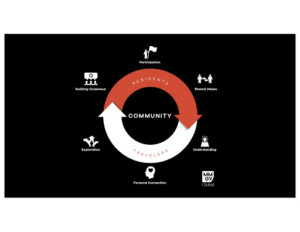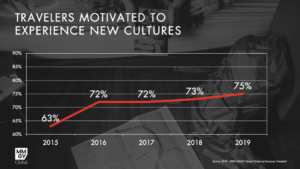Prior to this year’s pandemic, the travel industry had enjoyed nearly a decade of unsurpassed growth and had become a provider for one in every 10 jobs across the globe. Business was good. However, there was a growing recognition that as economies were beginning to soften, tourism was also vulnerable. Thus, for the last two years there have been many predictions about the future for destination organizations and how they would need to evolve to remain relevant.

Of course, all of this changed in 2020 as travel organizations pivoted from discussion about future-proofing to a focus on immediate survival. And with group and citywides drying up and corporate travel coming to a near standstill, one of the hardest hit segments has been DMOs.
Despite this, destination organizations prevailed in a leadership role for their communities around safety and optimism. In an early Q2 study we conducted among DMOs, we learned that nearly every organization surveyed had listed the sharing of information related to COVID-19 with industry partners as their priority. And more than 80% were using their websites as hubs for information and links about the pandemic for visitors and residents alike.
As the deployment of vaccinations has buoyed a sense of hope and optimism for travel in 2021 – with all eyes turned toward recovery planning – we see intent markets moving up in our data. But where does that leave destination organizations? Now more than ever these organizations must prove their relevance to ensure TID renewals, tourism tax appropriations and general funding in public budgets that are stretched.
It all revolves around community. 
There’s a reason resident sentiment studies and community engagement strategies have become such a fashionable trend in recent years among destination organizations. DMOs and tourism bureaus have realized that reporting KPIs aligned with the priorities of locals results in support for continued funding and an ability to fend off anti-tourism sentiments. However, where these initiatives have fallen short in the past is exactly where we believe destinations should focus their recovery efforts today: a recognition that the community is not exclusively for residents and local business owners. Rather, it is a shared network between both locals and visitors. Community goals around the support of local businesses, protection of environmental assets and cultural inclusivity are values that can be shared between tourists and residents. And, ultimately, visitors will help become the engine that feeds this success.
MMGY was fortunate to have recent AAF Hall-of-Fame Inductee Marcus Collins join us for our virtual industry Summit at Vail this year. Marcus speaks a lot about the expansion of networks as an evolution to audience segmentation and persona development in marketing. It’s not far-fetched to believe that travelers would be motivated to visit places where they could become a part of a shared community or network. According to our Portrait of American Travelers® data, two-thirds of all travelers say that they do not want to feel like a tourist on vacation, 58% seek access to local experiences that are otherwise inaccessible, and 80% want to enjoy authentic foods eaten by locals – far and away the top culinary choice when traveling.
Strong travel brands will use 2021 as an opportunity to hit the reset button in the coming year, re-evaluating long-term strategy and metrics for success. For destination organizations, we see this reset being grounded in the concept of shared community that follows four key pillars.
1. COMMUNITY STEWARDSHIP
There are many DMOs that have already recognized the shift to residents as a core audience. For example, the Colorado Tourism Office, led by Director Cathy Ritter, made a concerted effort in 2019 to connect insights from resident sentiment to their visitor messaging strategy, launching a Colo-Ready campaign. And many CEOs, like San Francisco Travel’s Joe D’Alessandro, have been vocal about shifting the focus of tourism marketing in recovery to more local engagement and connection. However, in the community-centric model we have outlined above there emerges a different definition for community – one that is tied to stewardship and goes beyond local stakeholders and residents. DMOs have an opportunity to become the bridge between visitors and locals – fostering this expanded network of shared values, experiences and goals. This places destination organizations at the heart of economic recovery and future growth for the cities, states and regions that they represent, which not only prioritizes public funding for the DMO but also relies on it as the leader for growth and community prosperity.
2. DIVERSITY, EQUITY AND INCLUSION
 A core component to serving the community in 2021 will be a focus on transforming our industry’s approach to diversity, equity and inclusion. Wave 1 of our Black Traveler Insights study has shown that this segment of the population has long been undervalued – having a spending influence in 2019 that is nearly double what has been historically reported. And this is just an example of one overlooked group. CEOs like Destination DC’s Elliott Ferguson and Visit Baltimore’s Al Hutchinson have led the effort in making DEI a priority this year among DMOs. Yet, the coming year will require more than an embracing of these underrepresented groups among our shared communities. Instead, we must put in the work to better understand how to serve the needs of locals and visitors alike across all communities. And, destination organizations are best positioned to play this pivotal role.
A core component to serving the community in 2021 will be a focus on transforming our industry’s approach to diversity, equity and inclusion. Wave 1 of our Black Traveler Insights study has shown that this segment of the population has long been undervalued – having a spending influence in 2019 that is nearly double what has been historically reported. And this is just an example of one overlooked group. CEOs like Destination DC’s Elliott Ferguson and Visit Baltimore’s Al Hutchinson have led the effort in making DEI a priority this year among DMOs. Yet, the coming year will require more than an embracing of these underrepresented groups among our shared communities. Instead, we must put in the work to better understand how to serve the needs of locals and visitors alike across all communities. And, destination organizations are best positioned to play this pivotal role.
RESPONSIBLE AND REGENERATIVE TOURISM
There are some who fear that the travel industry’s momentum in responsible tourism and environmental sustainability may take a step backward in the face of rebuilding revenue and profitability in 2021. In contrast to this, destinations like Greater Victoria, Canada, have actually reached carbon neutrality this year according to CEO Paul Nursey. The New York Times published an article earlier this year suggesting that our industry has an opportunity to go beyond sustainability and focus on regenerative travel and tourism. Our pre-pandemic data tells us that there is an inherent demand from travelers who expect a level of corporate social responsibility from their travel suppliers and that they are willing to pay a premium for it. And, with a recent Harris poll suggesting that 67% of consumers are now reappraising their personal values and lives to focus on what really matters, we believe this sentiment will become even more pervasive in 2021. In a model where destination organizations serve as a bridge between visitors and residents, DMOs will be critical in ensuring that the entire community can rally around the protection of culture and natural assets within the destination.
EVOLVING THE MODEL
Whether you call it destination marketing, destination management or destination strategy, the role of the DMO is clearly evolving. Gone are the days that occupancy percentage, ADR and in-market spend are considered the sole markers for success. Little Rock CVB’s CEO Gretchen Hall recently helped lead an effort around the development of the city’s downtown entertainment district, and in Grapevine, Texas, P.W. McCallum has partnered with elected officials to lead a public/private development project that has helped to lure light rail into the historic downtown. Destinations International has recognized this shift and is working with MMGY NextFactor to launch the next wave of the DNEXT Futures Study in 2021, which will build new industry benchmarks in a post-pandemic reality. And new data intelligence platforms like Entrada and Symphony by Tourism Economics are providing DMOs with an opportunity to re-envision what KPIs and metrics look like moving forward. The more DMOs lean into broader economic impact and overall community development, the greater the relevancy these organizations will continue to have in 2021 and beyond.
Tourism is the world’s front door.
We have long known that traveler intent and motivations are changing. We’ve seen year-over-year growth in travelers who are motivated to experience new cultures, and the events of 2020 only stand to increase this trend.

Tourism has the power to serve as a front door for us to share our local culture with others, open up dialogues about our similarities and differences, and to drive tax funding and reinvestment in local small businesses that have been hit so hard in 2020. Communities can become so much more than just locals vs. visitors, and the destination organizations that embrace this will help lead our industry in recovery.
To continue this conversation or to learn more about MMGY Global’s products and services, contact Craig